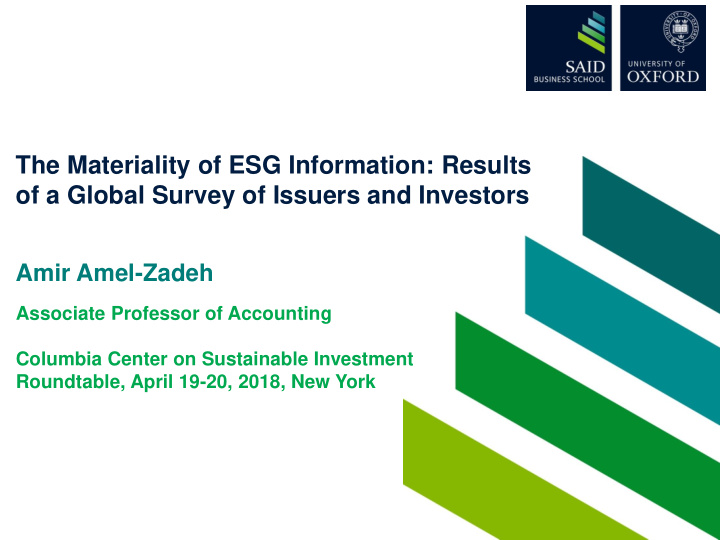



The Materiality of ESG Information: Results of a Global Survey of Issuers and Investors Amir Amel-Zadeh Associate Professor of Accounting Columbia Center on Sustainable Investment Roundtable, April 19-20, 2018, New York
Survey respondents The survey captures 40% of total global assets under management. 925 Asset $24.5 396 managers $6.4 Asset owners 242 Publicly listed $3.8 287 companies AUM/Market capitalization (US$ tn) Respondents Amir Amel-Zadeh – Global Survey on Materiality 2
Respondents’ geography The survey represents international companies and investors. Amir Amel-Zadeh – Global Survey on Materiality 3
Respondents’ size & industry Amir Amel-Zadeh – Global Survey on Materiality 4
Do investors consider ESG information when making investment decisions? The vast majority of investors consider ESG information in investment decisions although this varies by size and geography. % of investors that consider ESG information in investment decisions 93.2% 86.0% 85.9% 84.4% 80.3% 75.2% 75.0% >5 US$bn <5 US$bn >5% <5% US Europe RoW AUM ESG Allocation Geography Amir Amel-Zadeh – Global Survey on Materiality 5
Why do investors consider nonfinancial information in investment decisions? US and European investors agree on materiality. Investors consider nonfinancial information in investment decisions, because… 55.7% … such information is material to investment performance 64.4% 33.0% … of growing client/stakeholder demand 39.3% 25.8% … it is effective in bringing about change at firms 40.7% 47.4% … it is part of our investment product strategy 30.4% 18.6% … we see it as an ethical responsibility 40.7% US Europe Amir Amel-Zadeh – Global Survey on Materiality 6
Why is nonfinancial information material to investment decisions? Issuers underestimate investors’ consideration of latent risks. Nonfinancial information is material to investment decisions because… (% agree or strongly agree) 96% 92% 86% 88% 85% 85% 83% 82% 82% 81% 74% 70% 67% 62% Affects a Exposes Signals a Signals a Addresses Reveals Reflects a company’s company’s long - company’s company’s potential threats investor's increasing reputation and of litigation and term approach to management ethical, social, consumer, competitive regulatory environmental, employee, brand business quality position relative intervention strategy or governance public, or to its peers mandates political pressure on the company Investors Issuers Amir Amel-Zadeh – Global Survey on Materiality 7
Which nonfinancial information is material to issuers in which sectors? Governance matters for all sectors, so do employee policies. The materiality of other ESG factors varies across sectors. Materiality (ESG factor – Sector) Matrix Materials Industrials Energy Utilities Transport Services Retail Financials Health TMT Climate Change Energy & Water Waste & Environment Governance Product Impact Community Impact Employee Policies Suppliers’ ESG Policies Human Rights = highly material Not material = Amir Amel-Zadeh – Global Survey on Materiality 8
Does climate change pose a material risk to issuers? Climate change is a real concern for investors, in particular with respect to stranded assets and regulatory risk Climate change poses little or no risk Investors 25% Issuer 46% Climate change poses the following risks (difference in % responses issuers vs investors) Risk of stranded assets -18% Regulatory and litigation risk -17% 6% Risk to employee safety Risk to operations and supply chain 7% Risk to customer demand 20% More important to issuers More important to investors Amir Amel-Zadeh – Global Survey on Materiality 9
Supply and demand of ESG information A mismatch exists between the supply of and demand for specific ESG data points 20% 15% 14% 13% Higher investor demand for these data points than issuer supply 11% 11% 9% 8% 8% 5% 4% 4% 2% 1% 0% -3% -3% Larger issuer supply of these -5% -5% data points than investor demand -9% -10% -11% -11% -12% -13% -14% ESG issues identified as material by investors -16% Amir Amel-Zadeh – Global Survey on Materiality 10
Challenges investors face when integrating ESG information The lack of reporting comparability and standards are the biggest hurdle to ESG integration 45% 44% 41% 40% 38% 35% 29% 27% 17% 10% 3% 1% 11
What data source do investors use? Investors predominantly use data aggregators/third party ESG ratings for decision making Specialty Vendors/ ESG ratings agencies 37% Internal source 35% We do not have a ESG/ SRI strategy 20% Investment Consultants 18% Reports by NGOs/ non-profit organizations 15% Other 13% Custodian/ Asset Servicing Agent 12% Amir Amel-Zadeh – Global Survey on Materiality 12
Recommend
More recommend